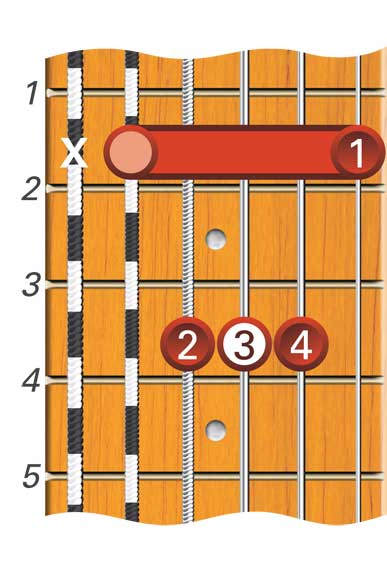
Fingerpicking Patterns
A fingerpicking pattern is when the right hand picks the strings in a set order and repeats that order of strings over and over again. The pattern is often played throughout a chord progression, i.e., the right hand maintains a strict right hand pattern as the left hand changes through different chord shapes.
Four String Chord Shapes
Incorporating picking patterns to Rock fingerpicking usually involves playing four string chord shapes. This is particularly the case when using an electric guitar in a band situation, where a bass player may be playing the root bass note of the chord. In this instance it is not necessary for the guitarist to fingerpick a full chord.
The most common four string chord shapes are played on the first four strings. These chord shapes are based directly on movable bar chord shapes, many which have already featured throughout this book.
Major chords
Root Four
Root Two
Root Three
Root Three




Minor Chords
Root Four
Root Four
Root Three
Root Two




Seventh Chords
Root Four
Root Four
Root Three
Root Three




Arpeggio Style
The distinguishing feature of the arpeggio style is the playing of the "arpeggio" within a chord shape. The arpeggio refers to the notes that make up the chord. Common arpeggio playing is the playing of the notes within the chord shape from the lowest note to the highest note and back to the lowest note.
The following exercise introduces the arpeggio style using a root 4 major chord shape (A). Note that the a finger is used to pick the first string.

The arpeggio style is used in the following lick.

The next example uses a variety of chord shapes. Several left hand techniques have been incorporated into the arpeggio pattern using extra notes based around each chord shape.




The arpeggio picking style is often used as an accompaniment for songs in ^ time. Many Rock ballads are in ^ time and use the guitar to play the arpeggio style as the main part of the arrangement. The following example is in ^ time.


The next chord progression introduces a picking pattern in ^ time that uses a pinch. Special attention should be given to the right hand fingering. This time it is not necessary to use the right hand a finger as the picking pattern is almost entirely in the first position.




String Muting
When using four string chords it is important to be aware of the two strings not being played. It is essential that these strings are muted so they do not sound. Open strings can cause unwanted noises such as overtones and feedback. Four methods of muting are:
- Touching the bass strings near the bridge with the palm of the right hand.
- Touching the bass strings with the left hand thumb.
- Touching the bass strings with the tip of a left hand finger.
- Touching the first string with the side of the first finger.
Study these photos and try applying the technique to the following new chord shapes.




More Four String Chord Shapes
The next set of four string chord shapes are on the middle four strings (strings 2-5). These chord shapes will also be useful when playing a picking pattern as an accompaniment.
Major Root Four
Major Root Five
Minor Root Four



Minor Root Five
Seventh Root Five
Seventh Root Five



Alternating Thumb Style
What is distinct about the alternating thumb style is that the thumb alternates between two notes within a chord shape on every beat of the bar. The pattern generally begins with the thumb playing the lowest note within the chord. On the next beat the thumb will play the next highest sounding string in the chord.
These two notes are repeated over and over again for the duration of the chord. The important thing to remember with this type of picking is that the thumb picks a string on every beat of the bar. This helps to give a solid beat to the picking sound.
The alternating thumb style is used in the following example. The new four string chord shapes introduced on the previously in this lesson.

Now an alternating thumb style pattern that uses a pinch. This chord progression many of the four string chord shapes introduced in this lesson.


Moving Bass Lines
Another common feature found in Rock fingerpicking is the use of moving bass lines. The first note played with the thumb on each chord connects with the next chord by moving in one or two fret steps.
The following example employs a moving bass line on the 4th string. Three new chords are introduced. The Dm/C# is a D minor chord with a C# bass note. The Dm/C is a D minor chord with a C bass note and the Dm/B is a D minor chord with a B bass note.
Dm/c
Dm/c
Dm/B





The final example in this lesson combines the arpeggio and alternating thumb styles.

